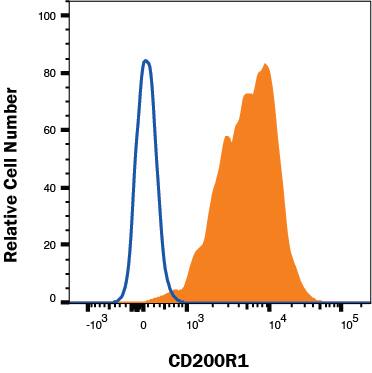Human CD200R1 APC-conjugated Antibody
R&D Systems, part of Bio-Techne | Catalog # FAB3414A


Key Product Details
Species Reactivity
Applications
Label
Antibody Source
Product Specifications
Immunogen
Ala27-Leu266 (predicted)
Accession # NP_620161
Specificity
Clonality
Host
Isotype
Scientific Data Images for Human CD200R1 APC-conjugated Antibody
Detection of CD200 R1 in Human Blood Monocytes by Flow Cytometry.
Human peripheral blood monocytes were stained with Mouse Anti-Human CD200 R1 APC-conjugated Monoclonal Antibody (Catalog # FAB3414A, filled histogram) or isotype control antibody (Catalog # IC0041A, open histogram). View our protocol for Staining Membrane-associated Proteins.Detection of CD200R1 in HEL-92 vs Jurkat cells by Flow Cytometry
HEL-92 (filled histogram) and Jurkat cells (open histogram) were stained with Mouse Anti-Human CD200R1 APC-conjugated Monoclonal Antibody (Catalog # FAB3414A). View our protocol for Staining Membrane-associated Proteins.Applications for Human CD200R1 APC-conjugated Antibody
Flow Cytometry
Sample: Human peripheral blood monocytes
Formulation, Preparation, and Storage
Purification
Formulation
Shipping
Stability & Storage
- 12 months from date of receipt, 2 to 8 °C as supplied.
Background: CD200R1
CD200 R1, also known as OX-2 receptor, is a 90 kDa transmembrane protein in the immunoglobulin superfamily (1‑3). The standard human CD200 R1 cDNA encodes a 325 amino acid (aa) precursor that includes a 28 aa signal sequence, a 215 aa extracellular domain (ECD), a 21 aa transmembrane segment, and a 61 aa cytoplasmic domain. The ECD is composed of one Ig-like V-type domain and one Ig-like C2-type domain (4). Within the ECD, human CD200 R1 shares 56% aa sequence identity with mouse and rat CD200 R1. Alternate splicing of the human CD200 R1 mRNA generates four isoforms, two of which are truncated in the Ig-C2 domain and are likely secreted. The protein expressed here contains a mature region that is identical to that of the standard form. There is an N-terminal extension of 25 aa that, in the standard form, is part of the signal sequence. In human, a separate CD200 R12 gene encodes a protein that shares 81% ECD aa identity with CD200 R11. In mouse, at least four genes for CD200 R1-like molecules have been described (4‑6). CD200 R1 expression is restricted primarily to mast cells, basophils, macrophages, and dendritic cells (7‑9), while its ligand, CD200, is widely distributed (10). Disruption of this receptor-ligand system by knockout of the CD200 gene in mice leads to increased macrophage number and activation and predisposition to autoimmune disorders (11). Association of CD200 with CD200 R1 takes place between their respective N-terminal Ig-like domains (12). The capacity of CD200 R1-like molecules to interact with CD200 is controversial (5, 13). CD200 R1 propagates inhibitory signals despite its lacking a cytoplasmic ITIM (immunoreceptor tyrosine-based inhibitory motif) (8, 9, 14, 15) CD200 R1-like molecules, in contrast, are potentially activating receptors by means of their association with DAP12 (4, 6).
References
- Rosenblum, M.D. et al. (2006) J. Dermatol. Sci. 41:165.
- Gorczynski, R.M. (2005) Curr. Opin. Invest. Drugs 6:483.
- Barclay, A.N. et al. (2002) Trends Immunol. 23:285.
- Wright, G.J. et al. (2003) J. Immunol. 171:3034.
- Hatherley, D. et al. (2005) J. Immunol. 175:2469.
- Voehringer, D. et al. (2004) J. Biol. Chem. 279:54117.
- Shiratori, I. et al. (2005) J. Immunol. 175:4441.
- Cherwinski, H.M. et al. (2005) J. Immunol. 174:1348.
- Fallarino, F. et al. (2004) J. Immunol. 173:3748.
- Wright, G.J. et al. (2001) Immunology 102:173.
- Hoek, R.M. et al. (2000) Science 290:1768.
- Hatherley, D. and A.N. Barclay (2004) Eur. J. Immunol. 34:1688.
- Gorczynski, R. et al. (2004) J. Immunol. 172:7744.
- Jenmalm, M.C. et al. (2006) J. Immunol. 176:191.
- Zhang, S. et al. (2004) J. Immunol. 173:6786.
Long Name
Alternate Names
Gene Symbol
UniProt
Additional CD200R1 Products
Product Documents for Human CD200R1 APC-conjugated Antibody
Product Specific Notices for Human CD200R1 APC-conjugated Antibody
For research use only
